[This post was originally published on 22nd April 2021. It has been updated on 16th March 2022.]
For an important upcoming holiday, your email marketing team works hard to devise the strategy, segment your target audience, choose the right templates, create amazing copy, design, and layout, and set up testing and post-campaign analytics.
You then send the campaign to your subscribers, confident that you will achieve your stated goals.
But it doesn’t quite happen that way.
You then send the campaign to your subscribers, confident that you will achieve your stated goals.
Too many of your carefully-crafted emails ended up in your audience’s Junk folder instead of their Inbox. This led to low open and click-through rates, a high number of bounces, and very poor engagement.
If most of your emails have landed in your subscribers’ Junk folders instead of their Inbox, you have an email deliverability problem.
In this guide, we’re going to do a deep dive into email deliverability – a common problem for virtually all email marketers. Keep reading to understand:
- What is email deliverability
- Why is Email Deliverability Important?
- The Three Aspects of Email Deliverability: I-R-C
- What is the “Best” Email Deliverability Rate?
- Common Issues that Affect Email Deliverability
- The Role Of Email And Sender Reputation
- A Brief Guide to Email Bounces
- The Graveyard for Email Deliverability: Spam!
- How to Boost Email Deliverability with Authentication
- The Role of Infrastructure In Email Deliverability
- Content is King – for Email Deliverability!
- Opt-ins and Unsubscribes are Important
- Useful Tools to Improve Email Deliverability
- How To Test Email Deliverability Before Sends
- Email Deliverability Best Practices To Swear By
- Wrap-up
What is Email Deliverability?
Email deliverability refers to your ability to deliver emails to recipients’ inboxes.
Email deliverability is often confused with email delivery, although the two are not the same.
Email delivery is when an email is successfully delivered to the receiving server, regardless of where it lands.
Email deliverability is when an email successfully arrives in the recipient’s Inbox.
It is possible to have good email delivery but poor deliverability.
Delivery issues usually mean that something is wrong with your email infrastructure. If users have blocked you due to a negative interaction, it will also affect your delivery rates. But deliverability is usually impacted by factors like Internet Service Providers (ISP), sender reputation, spam complaints, bounces, etc. It may also indicate that your subscribers are no longer interested in your content. We will cover these issues in this guide, and how to avoid them to maintain the best email deliverability for every campaign.
Why is Email Deliverability Important?
Email deliverability is a key success factor for email marketing.
Even if you design the world’s best email campaign and send it to the most perfectly-targeted audience, you may find that very few recipients actually open your messages. And if no one is opening your emails, you can’t expect good engagement, brand recall, or long-term brand loyalty. The root cause of poor open and click-through rates is usually a deliverability problem, and this is why you need to pay more attention to it.
You also need to find a way to fix it, or risk losing out on massive opportunities for customer engagement, sales, and profits. And this guide will show you how to improve email deliverability so this doesn’t happen to you!
The Three Aspects of Email Deliverability: I-R-C
i. Identification: Are you who you say you are?
This factor defines the protocols that prove you are who you say you are:
- Sender Policy Framework (SPF)
- DomainKeys Identified Mail (DKIM)
- Domain-Based Message Authentication, Reporting, and Conformance (DMARC)
ii. Reputation: Are you trustworthy as a sender?
Your reputation score signals whether you and therefore your emails are trustworthy. Blacklist listings, bounce rates, complaint rates, and email volumes all affect your reputation. If you can generate positive subscriber behavior by having them mark you as a “trusted sender”, you can boost your reputation with every ISP.
iii. Content: Does your audience like your content? Does it make an impact?
If your content is not appropriate, relevant or timely for your audience, your email deliverability will suffer. This is why it’s critical to create high-quality content with compelling subject lines, a clean layout and no spam words, and to personalize it as much as possible.
What is the “Best” Email Deliverability Rate?
Every email marketer aspires to achieve 100% email deliverability. Unfortunately, it’s next to impossible to achieve this utopia.
Your deliverability rates will depend on your ESP, your campaign’s I-R-C factors, and a host of other factors. Recent research by EmailToolTester found a huge variation in the first, with ActiveCampaign achieving 91.1% deliverability in March 2021, compared to just 75.1% by Benchmark. The average deliverability rate across 15 popular ESPs was 88.9%. Although this is 3% more than the average in September 2020, it still indicates an email deliverability problem where over 11% of emails go missing, or are caught by spam filters, and are therefore not seen by intended recipients.
Common Issues that Affect Email Deliverability
The critical factors that negatively affect email deliverability include:
i. Subscriber reactions
If your emails are unwanted, people will mark them as spam, so all your future emails will land in their Spam folder, negatively affecting your email deliverability. Deliverability will also be poor if your emails contain spammy words and are caught by email clients’ spam traps, or if they fail to comply with CAN-SPAM and other regulations.
ii. Low engagement
If too many of your subscribers are not engaging with, or even opening your emails, it could indicate to the email client that you are not following email best practices, so more emails will land in the Spam folder.
iii. High bounce rate
An email that can’t be successfully delivered and is sent back by the ISP is said to have bounced. This could indicate that the subscriber list is outdated, or purchased rather than built organically. This affects your reputation, and, as an extension, your email deliverability.
iv. Constantly switching between different ESPs
If you keep switching between ESPs, email clients may see you as a spammer that’s trying to hide their trail, which will affect your reputation, and consequently your email deliverability.
Other factors include:
- Sending times and frequency
- Audience segmentation
- Subscriber opt-ins
- Whether subscribers are active or disengaged
- Sender Authentication Package (SAP) package
- IP warm-up
- Use (or not) of good content, interesting subject lines, and high-quality visuals
The Role Of Email And Sender Reputation
Today’s consumers are too busy, too overwhelmed, and too impatient, so it’s critical to cultivate – and maintain –a good reputation if you want to keep your email deliverability rates high. Modern users are also familiar with numerous ways to block unwanted emails so senders have to become more and more creative to avoid getting into the spam folder.
Every time you send an email campaign, mailbox clients run some “reputation checks” which are affected by:
- Sender reputation
- Server / IP reputation
- Domain reputation (of content links)
- Email engagement metrics
- Bounce rates
- Spam complaints for your sender, domain and server
Your sender reputation score is calculated on a scale of 0 to 100. Several factors may increase or decrease your sender reputation. These include:
i. Campaign and email volume
Major drops or big spikes in campaign volumes can cause the sender reputation to tank.
Occasionally, you may need to send out more emails than usual, e.g before Christmas, to promote a Black Friday sale, etc. But as far as possible, try to distribute your email marketing campaigns evenly.Your subscribers will know what to expect schedule-wise, which will help increase open and click-through rates.
ii. Reputation warm-up
Reputation warm-up is the process of improving your sender reputation profile to avoid the Spam folder. To do this, gradually increase the number of emails you send based on a set schedule.
Reputation warm-up is especially important if:
- Your subscriber list has over 50,000 contacts
- You have just gained a new dedicated IP address
- You are new to email marketing and don’t yet have a sender reputation
Best practices to get started with reputation warm-up
Gradually increase your email volume for successive campaigns so that it looks something like this:
If you are moving to a new ESP, migrate only those contacts who regularly open and click your emails. This will clean up your subscriber list, improve your reputation, and boost your deliverability.
iii. MX records
Always set up a valid DNS MX (mail exchange) record for your sender domain. It indicates how your emails should be routed in accordance with the SMTP protocol. Without it, some ISPs may not be able to identify the mail servers for your recipients, and automatically block your emails.
iv. Sender’s email address
Your campaigns must represent your brand, and this includes using your brand’s email domain and a professional email address. If you don’t, your emails may be considered spam by various email clients, and land in subscribers’ Spam folders.
A Brief Guide to Email Bounces
Emails are usually marked as “bounced” if they cannot be delivered and are sent back by the ISP. They impact email deliverability, and are a waste of your team’s resources. The good news is that ISPs send messages back to the email sending platform with an explanation of why the email bounced. By analyzing these responses, you can understand the root causes, and take action to fix the underlying problem(s). In most ESPs, if a recipient’s email server accepts the email, their status remains Active, but if it rejects the email, their status changes to Bounced.
i. Soft bounce
A soft bounce can be caused by a full mailbox, an inactive account, or a temporary domain failure. It is usually temporary, so you shouldn’t remove these email addresses from your subscriber list. However, you should reconsider if your messages to certain email addresses are consistently bouncing.
ESPs usually try to re-send soft bounce emails at a set schedule for a certain number of hours and tries. When the system stops further retry attempts, the subscriber appears as Bounced.
ii. Block bounce
This type of soft bounce occurs when the email server rejects the email due to a blacklisted IP address, lack of proper authentication, URL blocks, or content filtering.
iii. Technical bounce
This soft bounce occurs due to technical issues like a busy server, network error or data format error.
iv. Hard bounce
This results from a permanent condition like an invalid, non-existent or closed email address, or a bad or non-existent domain. Since these emails will never be successfully delivered, no further attempts are made to send this email to this subscriber.
Here’s how a subscriber’s status changes from Active to Bounced to Undeliverable. A knowledge of these linkages can help with bounce investigation and prevention.
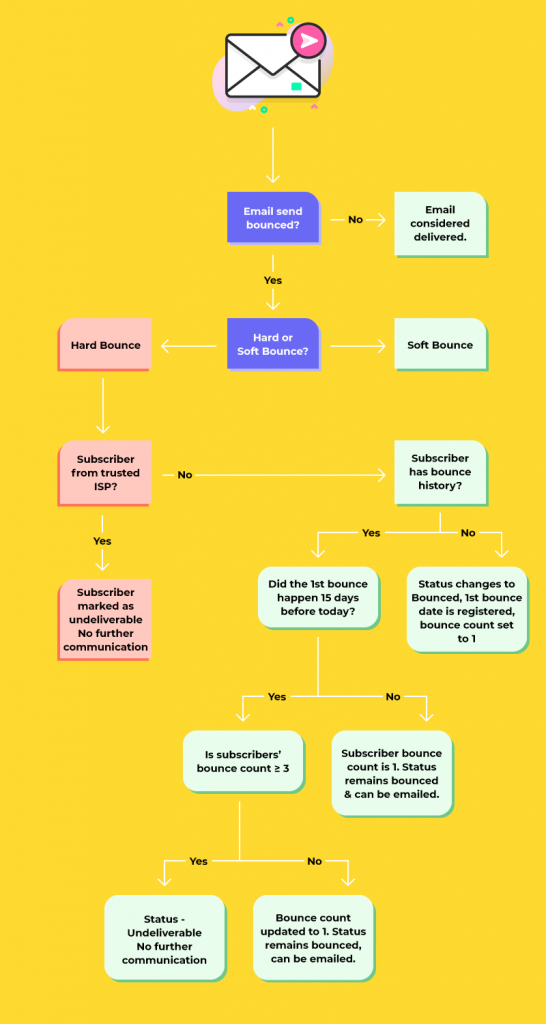
General best practices to keep your bounce rates down
- Use an email verifier to ensure that the email addresses on your list are valid
- Check your ESP’s SMTP response code to verify if the bounces are hard or soft
- Check if your ESP provides different bounce reports to help you analyze root causes:
- Email Performance by Domain: For domain-specific deliverability issues like blacklisting or spam complaints
- Spam Complaints over Time: To check how many complaints are received from specific domains that offer spam reporting
- Bounce Event Extract File: Granular information about SMTP error codes for each bounced subscriber
You should also:
- Configure your Sender Authentication Package (SAP) to ensure that email providers see your domain as legit
- Give email servers some time to get used to your IP address
- Mind and maintain your reputation
- Only email people who have specifically opted-in
- Test for content-related issues (e.g. spammy words)
The Graveyard for Email Deliverability: Spam!
Someone may mark your email as “Spam” because:
- Your emails are no longer relevant to them
- They don’t want to engage with your brand
- They were offended by something you sent in the past
- They find your email frequency annoying
- They don’t appreciate your use of certain words in the content or subject line
When your subscribers hit the “Mark as spam” button, mailbox providers receive a notification, and automatically block the sender.
Spam traps are fake email addresses that look real. They are set by ISPs and blacklist providers to catch unscrupulous email marketers who purchase lists, or email people who didn’t give explicit permission. Sending even a few emails to these addresses tells the ISP that the sender has built their list unnaturally. This sets off the spam trap, and automatically marks them as a spammer.
And that’s why you should never purchase an email list.
Emailing people who didn’t explicitly agree to receive your emails can also lead to more spam complaints, which can significantly harm your domain’s reputation, and get you blocked on future campaigns.
Finally, make sure you don’t get blacklisted!
A blacklist is a list of sender domains or IP addresses that have been caught sending email spam. There are 100+ blacklists but you can stay off of them if you avoid sending emails from a blacklisted server or domain. Continuously monitor blacklists to stay off of them.
How to Boost Email Deliverability with Authentication
To get legitimate users to open their emails, “spambots” and spammers try to impersonate real people or organizations. To prevent this, ISPs implement several gate-keeping authentication techniques. That’s why it’s important to know more about them.
Sender spoofing
Spammers use sender spoofing by changing a few header values to impersonate your brand’s email and send campaigns on your behalf.
But modern ISPs are getting better at catching this type of spam so that your email deliverability rates are not considerably affected. They do this by performing an authentication check when receiving a new email, first by checking the IP address where the message originated, and then by checking if that IP address has permission to send emails on behalf of yourdomain.com.
Set up authentication in your ESP to ensure that only legitimate emails go out from yourdomain.com, and that email clients recognize that you have given consent to send emails on your behalf.
Two ways to set up authentication
i. Sender Policy Framework (SPF)
SPF is an email validation system that verifies the sender’s IP address to prevent spam. It tells an incoming server which web hosts are authorized to send emails from a given domain. The server does a quick check on incoming emails. If it finds no match in the authorized list, it rejects the email.
ii. DKIM (DomainKeys Identified Mail)
DKIM validates if an email was indeed sent by the owner of a given email address. If it fails, the receiving server understands that the sender might not be who they claim to be.
Which method should you use to authenticate your emails?
Both
Using both simultaneously makes it clear to incoming servers that you and your emails are legit, which reduces spam, increases your sender reputation and ultimately prevents email deliverability issues.
A word of caution: While DKIM and SPF are great for boosting email deliverability, they do not ensure that your emails will always pass spam filters, and land in your subscribers’ Inboxes. Also, SPF and DKIM checks are not enough to ensure the recipient’s safety, so you should consider extra authentication with DMARC.
iii. DMARC (Domain-based Message Authentication, Reporting & Conformance)
DMARC adds an extra authentication check to improve your credibility, and protect your subscribers from bad actors. You will receive a report with details so you can check whether any spoofing has occurred.
Email encryption with TLS (Transport Layer Protocol)
Most emails are transmitted in un-encrypted form, making them vulnerable to information disclosure to unauthorized entities. To prevent this, it’s essential to encrypt emails with TLS.
The TLS protocol encrypts and delivers mail securely for both inbound and outbound mail traffic, prevents eavesdropping between mail servers, and keeps messages private. Encryption is a good way to ensure email security and deliverability.
The Role of Infrastructure In Email Deliverability
Your email infrastructure plays a big part in your email deliverability results. This includes elements like:
i. IP address
Your IP address impacts your sender reputation, which impacts email deliverability. Many ESPs offer shared IPs by default. Although this can reduce your costs, it also doesn’t give you any control over the IP’s reputation. This can lower your email deliverability.
So should you use a Shared IP or a Dedicated IP?
A shared IP may be sufficient for your needs if you send fewer than 200K-300K emails per campaign, or if you’re concerned about the quality of your mailing list.
A dedicated IP is best when you:
- Have hundreds of thousands of contacts and need to reach out to them regularly
- Maintain a consistent, healthy email volume
- Need to send out time-sensitive campaigns and cannot afford throttling and other issues caused by other senders (which can happen on a shared IP address)
ii. IP warming
IP warming is a process of gradually increasing the volume of messages sent from an IP address per a pre-determined schedule, to establish a good reputation with ISPs as a legitimate sender.
IP warming is especially important if you:
- Add a dedicated IP address to your account
- Have not sent emails from an IP address in over 30 days
ISPs look at email volume as a key factor to detect spam. They also look at emails coming from a new or “cold” IP address. That’s why IP warming is critical. You can warm up your IP:
- Manually: Gradually send more and more email over your IP address at a pre-determined schedule
- Automatically: Set up an email “throttle” in your ESP to send emails at a pre-determined schedule
Here’s a sample warming schedule if you have 100,000 subscribers in your email list:

iii. Feedback loops
Many email providers operate a feedback loop service to report back complaints to ESPs. For example, if a subscriber hits the “Mark as spam” button, the ESP gets a request through the feedback loop. Make sure your ESP monitors these loops and that you take action on this feedback. This can have a positive effect on your email deliverability rates.
iv. Abuse reporting mailbox
If you set up an abuse-reporting mailbox and monitor it frequently, you can improve email deliverability. You can implement it through the use of an email header.
Content is King – for Email Deliverability!
Irrelevant or outdated content, poor layouts, confusing designs, unresponsive templates can all affect your brand’s reputation and lower your email deliverability.
Content best practices to avoid deliverability issues
i. Make it relevant and personalized
Always provide value to subscribers, and only send messages that they signed up for. So if they signed up to get your latest blog posts, don’t turn your messages into sales pitches. If you fail to deliver on a promise, they will leave or mark you as a spammer.
Home Depot nails this email where they provide useful information and gently steer the reader to their products without getting in their face.
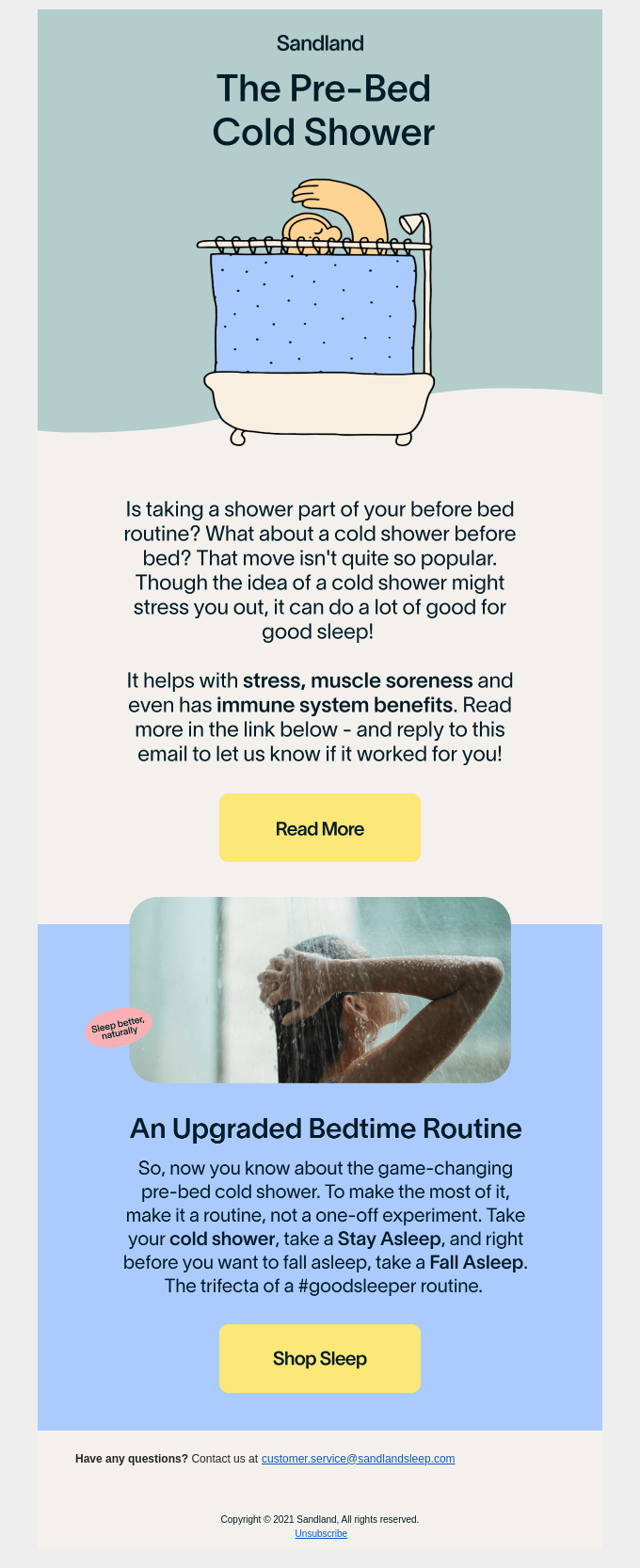
Personalizing your messages is a significant factor in boosting email deliverability. Some level of personalization is easier to do if you segment your mailing list to create subsets of your audience with common interests. Although not as effective as 1×1 personalization, it’s still better than no personalization at all. Also, many ESPs allow you to send hyper-personalized campaigns for certain email types, like cart abandonments or product recommendations.
Here’s how Food52 personalizes their cart abandonment email with an easy layout, relevant content, and an attractive contextual subject line.
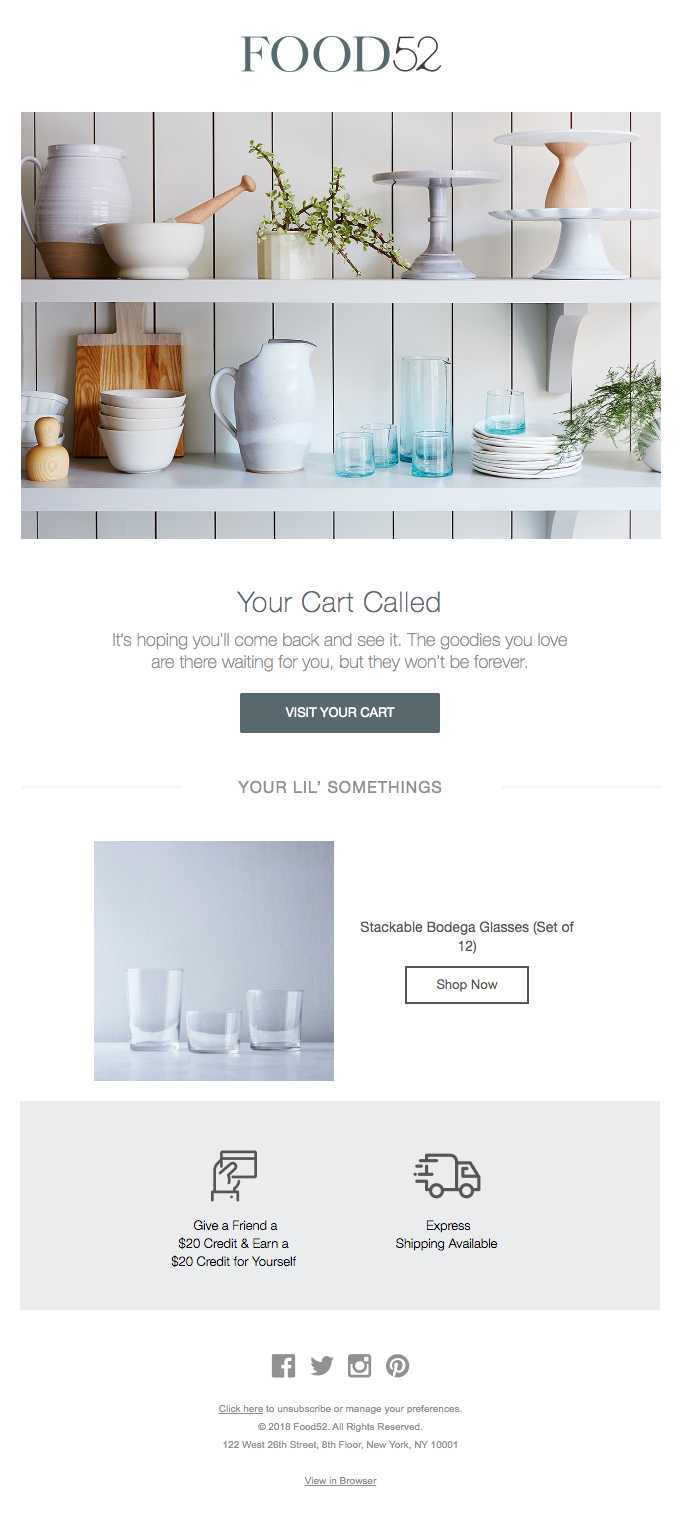
ii. Create consistent and mobile-friendly designs
Your email campaigns should have a consistent look and feel. Use your brand’s colors, fonts, and templates. Maintain your brand identity, and avoid making massive design changes between campaigns.
Mobile opens account for 46% of all email opens.
Emails that don’t render well on mobile devices will alienate users, and lead to more unsubscribes. That’s why it’s important to create mobile-friendly and responsive designs with high-quality images and copy, a clean layout, visible CTAs and lots of white space.
This email from Harry’s is perfectly optimized for mobile readers with a clean single-column layout, an optimal mix of text and photos, and a prominent CTA.
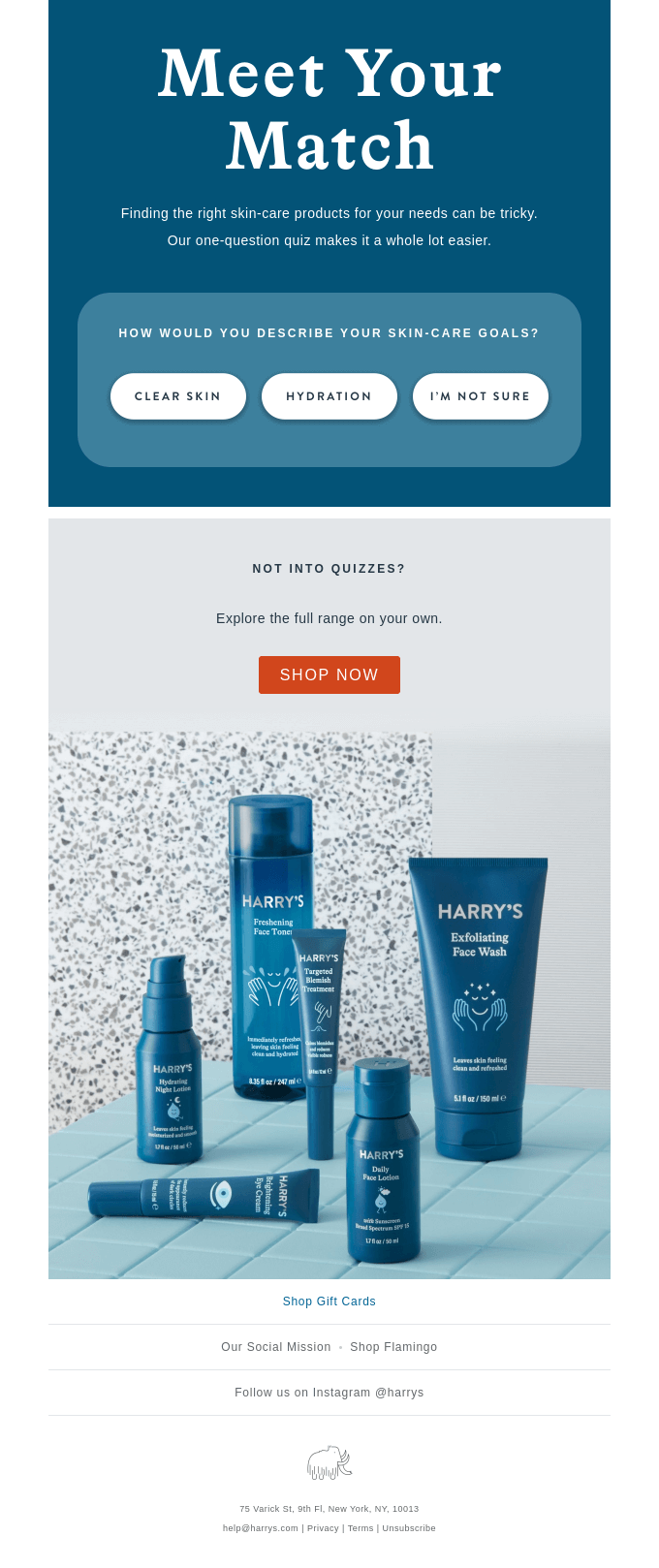
iii. Personalize the “From” field
To increase open rates, include both your company name for credibility, and the sender’s name for the “human factor”. For instance, John from Thiscompany is better than John Doe or, worse, Johndoe27580.
iv. Avoid spammy subject lines and spam words in copy
To avoid falling into a spam trap, avoid both spammy titles and spam words in copy. These include perennial favorites like:
- $$$
- 100% free
- Earn $
- Best price
- Big bucks
- Billion dollars
- Cash bonus
- Claims
- Free gift
v. Avoid using “no-reply” emails
ISPs usually favor senders who accept responses to legitimate addresses. A no-reply email stops subscribers from connecting with you, and can affect your email deliverability.
vi. Create both HTML and plain-text emails
HTML emails are visually-rich. But sometimes they don’t render properly on some email clients. By sending plain-text emails, you can still share information, provide value, and reach more subscribers.
vii. Be careful with URL shorteners
Spammers frequently use link shorteners to hide their malicious websites from users and mailbox providers. As a result, even legitimate senders may be penalized and marked as spammers. This affects email deliverability, so it’s best to avoid using public link shorteners.
Opt-ins and Unsubscribes are Important
Simply put, an “opt-in” indicates that a subscriber has explicitly agreed to receive an email from you. Since the email is wanted, your email deliverability will be high. Purchased or harvested lists contain email addresses of people who did not explicitly opt-in to receive your emails. That’s why they always cause email deliverability problems.
Opt-ins also indicate that:
- Subscribers trust your brand
- They want to hear from you
- They are willing to engage with you
There are two common forms of opt-in
i. Single opt-in
Email addresses are added to the list without requiring the owner to confirm definitively that they knowingly and willingly opted in.
ii. Double opt-in
This happens when a user signs up to receive your emails, and then confirms their intent in their Inbox by clicking on a confirmation link in a confirmation email. A double opt-in protects your mailing list from spambots and other invalid signups. Although it will result in a smaller mailing list (compared to a single opt-in mailing list), it will ensure a better-quality list, plus better email deliverability and inbox placement.
Honeygain sends this simple double opt-in email to ensure that the recipient has really signed up to hear from them.

In addition to managing your opt-ins, it’s also important to manage your unsubscribes. Immediately remove those who complained or unsubscribed from your mailing list. This will clean up your list, and ensure that the remaining audience is more likely to open your messages. It will also improve your sender reputation and thus, your email deliverability. Also set up a simple “preference center” in your ESP so those who don’t want to unsubscribe from all your communication can decide what they wish to receive and how often.
Best practices for opt-ins and unsubscribes
i. Make it easy to unsubscribe
A no-tricks link in the footer will keep your complaint rates low, maintain a high inbox placement, and protect your sender reputation.
ii. Purge your lists regularly
Remove bounces and dis-engaged users who are decreasing the quality of your list. Send re-engagement emails first. If they still don’t respond, say bye-bye to improve your list quality and your deliverability.
This simple email from Archant gives subscribers the power, while taking proactive steps to clean the list and increase email deliverability.
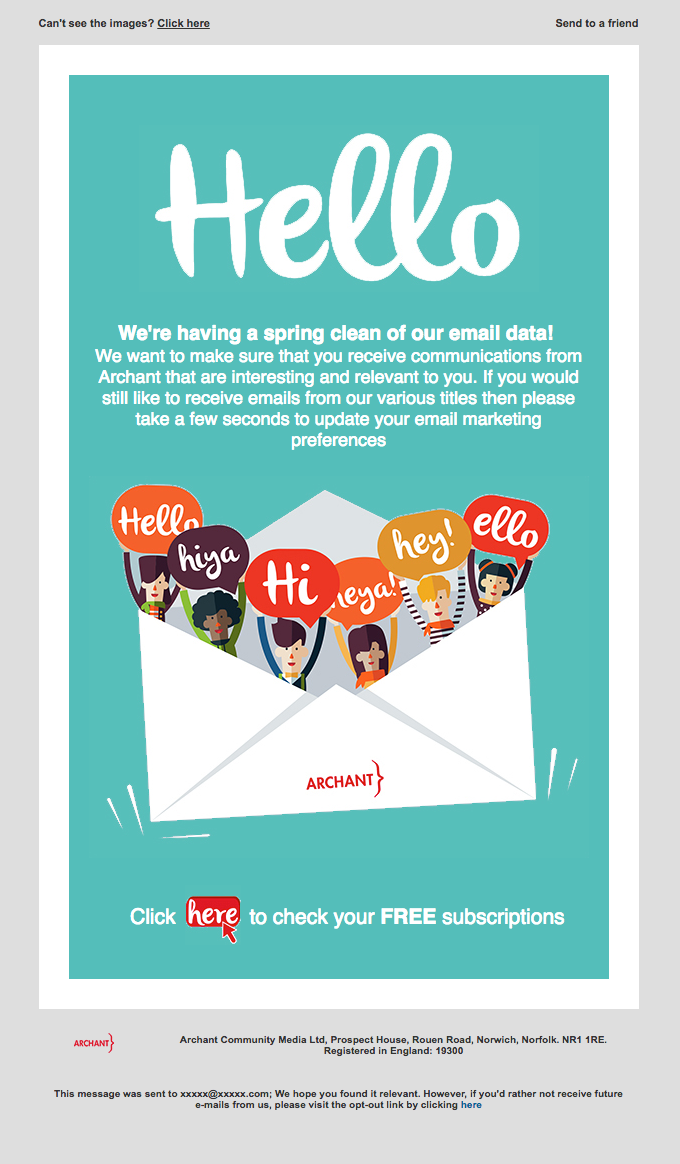
Useful Tools to Improve Email Deliverability
The following email deliverability tools should be an essential part of your email marketing toolkit.
i. List cleaning tools
These tools help purge your lists to lower bounce rates and increase email deliverability.
ii. Verification tools
Use an email verifier to check email addresses and ensure that they are valid. This will maintain list hygiene and also lower bounce rates.
iii. Blacklist check tools
A blacklist check tool will automatically check if your domain is blacklisted, so you can take action to de-list it and arrest your deliverability problems.
iv. Link shortener tools
If you do need link shorteners for your email campaigns, it’s best to implement your own with this tool.
v. Subject line tools
A subject line tester allows you to test for spammy words. Some even predict open rates of your subject lines over the industry average, guiding you towards useful modifications.
vi. Email testing tools
Use an email testing tool to check for factors bound to sender reputation.
Just keep in mind that tools are only as good as the person using them. Leverage them to support and guide you, not to do the heavy lifting.
How To Test Email Deliverability Before Sends
Instead of waiting to check email deliverability after sends and then applying fixes, test email deliverability before sends and take proactive action from the outset. Many tools are available to check deliverability, or at least some aspects of it.
i. Sender Score
It assesses your domain reputation and gives a “Sender Score” for each IP address that you’re known to send emails from. The higher the score, the more likely an email is to be delivered to a subscriber’s Inbox.
ii. MXToolbox
These tools can help you validate your reputation or check your domain health.
iii. Mail-tester.com
When you send an email to an individual address, the tool provides a detailed report with email deliverability tips on what to improve.
iv. Mailtrap
Set up a fake environment to check how emails look in various clients, analyze their spam score, and check if they’re properly delivered.
Email Deliverability Best Practices To Swear By
Before you put this guide into practice, keep in mind these additional email deliverability tips:
- Segment your email list to get the best possible engagement rate
- Remove or suppress inactive customers either a set time, or after an unsuccessful re-engagement campaign
- Simplify the unsubscribe process
- Create enticing and short subject lines
- Double-check your emails’ legality
- Ideal campaign frequency: 2-3 times/week
Wrapping It Up
We hope you find this email marketing deliverability guide useful. Do check out our other detailed guides on other aspects of email marketing including email marketing automation, best practices, and email open rates. Need any help with anything email marketing. Get in touch with Email Uplers.








Kevin George
Latest posts by Kevin George (see all)
Most Appealing Banner Fonts to Use in 2022
Minimalist Email Design – A Timeless Style You Must Embrace